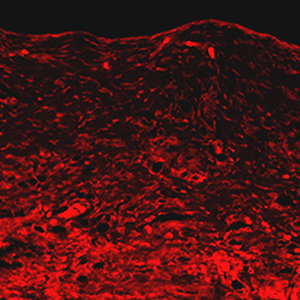Inhibition of HMGB1 suppresses inflammation and catabolism in temporomandibular joint osteoarthritis via NF-κB signaling pathway

Submitted: 2 November 2021
Accepted: 24 May 2022
Published: 21 June 2022
Accepted: 24 May 2022
Abstract Views: 987
PDF: 678
HTML: 14
HTML: 14
Publisher's note
All claims expressed in this article are solely those of the authors and do not necessarily represent those of their affiliated organizations, or those of the publisher, the editors and the reviewers. Any product that may be evaluated in this article or claim that may be made by its manufacturer is not guaranteed or endorsed by the publisher.
All claims expressed in this article are solely those of the authors and do not necessarily represent those of their affiliated organizations, or those of the publisher, the editors and the reviewers. Any product that may be evaluated in this article or claim that may be made by its manufacturer is not guaranteed or endorsed by the publisher.
Similar Articles
- Jianyu Zou, Zhenbin Cai, Zhi Liang , Yaozhong Liang, Guowei Zhang, Jie Yang, Yunlong Zhang, Hongsheng Lin, Minghui Tan, Different fusion tags affect the activity of ubiquitin overexpression on spastin protein stability , European Journal of Histochemistry: Vol. 65 No. 4 (2021)
- Tao Wu, Shikui Wu, Hui Gao, Haolei Liu, Jun Feng, Ge Yin, Astragaloside IV augments anti-PD-1 therapy to suppress tumor growth in lung cancer by remodeling the tumor microenvironment , European Journal of Histochemistry: Vol. 68 No. 4 (2024)
- Xiang Li, Yu Xie, An Kang, Yue Wang, New bitongling (NBTL) ameliorates rheumatoid arthritis in rats through inhibiting JAK2/STAT3 signaling pathway , European Journal of Histochemistry: Vol. 65 No. 1 (2021)
- D. Fanni, N. Iacovidou, A. Locci, C. Gerosa, S. Nemolato, P. Van Eyken, G. Monga, S. Mellou, G. Faa, V. Fanos, MUC1 marks collecting tubules, renal vesicles, comma- and S-shaped bodies in human developing kidney , European Journal of Histochemistry: Vol. 56 No. 4 (2012)
- C.A. May, I. Osterland, Merkel cell distribution in the human eyelid , European Journal of Histochemistry: Vol. 57 No. 4 (2013)
- M. Costanzo, F. Carton, A. Marengo, G. Berlier, B. Stella, S. Arpicco, M. Malatesta, Fluorescence and electron microscopy to visualize the intracellular fate of nanoparticles for drug delivery , European Journal of Histochemistry: Vol. 60 No. 2 (2016)
- L. Pilloni, P. Bianco, E. DiFelice, S. Cabras, M.E. Castellanos, L. Atzori, C. Ferreli, P. Mulas, S. Nemolato, G. Faa, The usefulness of c-Kit in the immunohistochemical assessment of melanocytic lesions , European Journal of Histochemistry: Vol. 55 No. 2 (2011)
- T. Al-dhohorah, M. Mashrah, Z. Yao, J. Huang, Aberrant DKK3 expression in the oral leukoplakia and oral submucous fibrosis: a comparative immunohistochemical study , European Journal of Histochemistry: Vol. 60 No. 2 (2016)
- Matias Garrido, Camila Escobar, Constanza Zamora, Carolina Rejas, Juan Varas, Mario Párraga, Sebastián San Martin, Sandra Montedonico, Bile duct ligature in young rats: A revisited animal model for biliary atresia , European Journal of Histochemistry: Vol. 61 No. 3 (2017)
- T. Nara, T. Yasui, O. Fujimori, W. Meyer, A. Tsukise, Histochemical properties of sialic acids and antimicrobial substances in canine anal glands , European Journal of Histochemistry: Vol. 55 No. 3 (2011)
<< < 32 33 34 35 36 37 38 39 40 41 > >>
You may also start an advanced similarity search for this article.

 https://doi.org/10.4081/ejh.2022.3357
https://doi.org/10.4081/ejh.2022.3357











